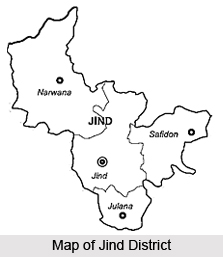 Geography of Jind District includes the north-central part of Haryana. Physiographically, it constitutes a part of the Punjab-Haryana plain, which is largely flat and featureless and is formed of Pleistocene and sub-recent alluvial deposits of the Indo-Gangetic Plain. Jind district is located in a transitional zone between the sub-humid districts in the east and the semi-arid districts in the west. Geography of Jind District comprises a flat, monotonous upland plain. It is evident from the fact that the general elevation of the district ranges between 218 meters and 239 meters above sea level.
Geography of Jind District includes the north-central part of Haryana. Physiographically, it constitutes a part of the Punjab-Haryana plain, which is largely flat and featureless and is formed of Pleistocene and sub-recent alluvial deposits of the Indo-Gangetic Plain. Jind district is located in a transitional zone between the sub-humid districts in the east and the semi-arid districts in the west. Geography of Jind District comprises a flat, monotonous upland plain. It is evident from the fact that the general elevation of the district ranges between 218 meters and 239 meters above sea level.
The climate of Jind District is on the whole dry, hot in summer and cold in winter. The year may be divided into four seasons. The cold season from November to March is followed by hot season which lasts till the onset of the south-west monsoon season. The monsoon season continues up to the mid of September and is followed by the Post-monsoon or the transition period. Average rainfall of Jind District as a whole is 55 cm. It generally increases from south or south-west to east or north-east. Over 70 per cent of the annual rainfall is received during the monsoon months of July to September. July and August are the rainiest months, together accounting for over 50 per cent of the annual rainfall. Per-monsoon rainfall in June constitutes just about 10 per cent of the annual normal. Some precipitation, constituting about 10 per cent of the annual rainfall, is also received during the winter months of December to February in association with western disturbances which pass across the district or its neighborhood from west to east, affecting the weather over the district in this season. The variation in annual rainfall from year to year is large.
From the beginning of March, temperature increases rapidly till June which is generally the warmest month. The mean daily maximum temperature during June is around 41 degree Celsius and the mean daily minimum around 27 degree Celsius. The heat in the summer season is intense. On individual days, the day temperature may occasionally exceed 47 degree or 48 degree Celsius. With the onset of the monsoon by the end of June or beginning of July there is a drop in the day temperature but the nights are nearly as warm as in June. Due to the increased humidity in the air, the weather is oppressive between the rains. After the monsoon season by the mid of September there is a decrease in temperature, the fall in the night temperature being more rapid. After October both day and night temperature decreases rapidly. January is usually the coldest month with the mean daily maximum temperature at about 21 degree Celsius, and the mean daily minimum temperature at about 6 degree Celsius in the winter season.
During the south-west monsoon-season of July to September, the relative humidity is high, being over 75 percent to 80 percent in the morning and 55 to 65 per cent in the afternoon. High humidity of more than 70 per cent also prevails during the winter months of December to February. It is comparatively drier during the rest of the year. April and May constitute the driest part of the year when in the afternoon the relative humidity is 20 per cent or even less. Moreover, the sky is moderately clouded mainly in July and August. Cloudiness decreases rapidly by October. From June onwards cloudiness increases. Winds are generally light. In the south-west monsoon season, winds from the south-west and west are more common. During the summer season, winds are from west or south-west in the morning. Thunderstorms, in association with pre-monsoon and monsoon rains occur mostly during June to September. During the winter season also, a few thunderstorms occur in association with the western disturbances.
There are minor undulations in the general physiographic formation of the district. These undulations characterise the area having been subject to wind action in the past and owe their existence to the presence of sand dunes, sand ridges and depressions at places. The sand dunes are now stable generally having a local relief of 2 to 6 meters. In brief, Jind District does not offer much physiographic diversity. It is flat, featureless, alluvial upland plain dotted only sporadically with sand dunes and depressions, yielding a local relief of not more than 6 metres either way. There is absence of any major stream or river in the district.
Jind District by and large is underlain by the quaternary alluvium comprising chiefly clays, sand of various grades, Kanker and occasionally gravel and pebbles. The soils of the Jind district are sandy and clayey. The area of Jind district is irrigated by two canal systems, Western Yamuna Canal and the Bhakra Canal. This district is not very rich in flora and there is no natural forest at present. Jind District is very poor as far as species of medicinal plants are concerned.



















